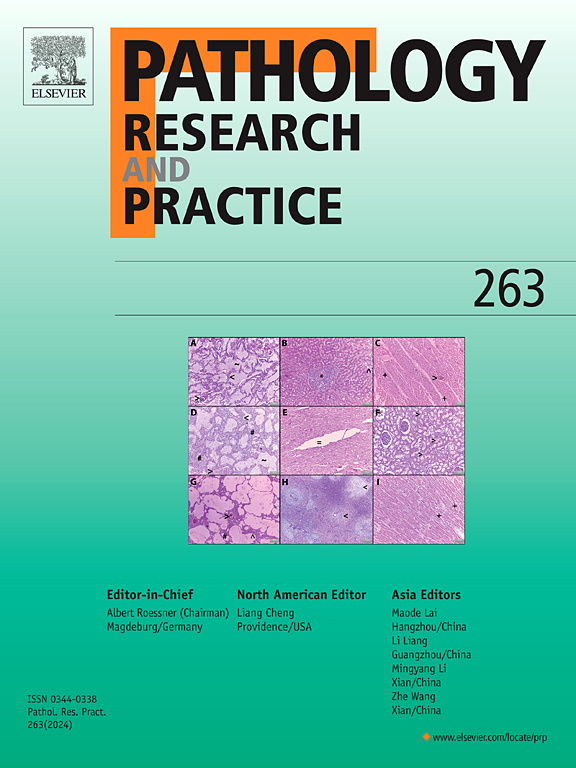用于胃肠道间质瘤有丝分裂自动检测的可解释机器学习框架。
IF 3.2
4区 医学
Q2 PATHOLOGY
引用次数: 0
摘要
有丝分裂指数是胃肠道间质瘤(GIST)分级的重要指标。传统的基于显微镜的有丝分裂计数是劳动密集型的,并且表现出观察者之间的可变性,需要自动化。然而,现有的模型已被证明不适用于GIST梭形细胞。为了解决这一限制,我们开发了一种用于GIST中有丝分裂自动检测的机器学习方法。首先建立了一个带有13965个有丝分裂细胞注释的GIST图像数据库。在细胞核分割、特征提取和特征选择之后,采用六种不同的算法在10 × 和40 × 放大倍数的图像上训练有丝分裂检测模型。径向基函数支持向量机(SVM-RBF)在两种放大倍数下均获得最佳性能(10 ×: F1 = 0.83;40 ×: F1 = 0.89)。然后通过两步级联双尺度方法进行滑动级有丝分裂计数,其中10 × 模型首先识别感兴趣区域(roi),然后使用40 × 模型进行精确检测和计数。玻片水平验证显示,自动和人工有丝分裂计数之间存在中度相关性(r = 0.4705),自动计数与Ki-67表达之间存在强相关性(r = 0.6187)。SHAP可解释性分析证实,该模型的决策依据与病理学家的诊断标准密切一致,包括核膜解体、染色质凝聚和染色体排列。总之,本研究建立了GIST中有丝分裂细胞检测和计数的第一个自动化框架。它强调了传统机器学习在靶向病理应用中的临床潜力,并展示了良好的可解释性。本文章由计算机程序翻译,如有差异,请以英文原文为准。
An interpretable machine learning framework for automated mitosis detection in gastrointestinal stromal tumors
The mitotic index is a critical indicator in grading gastrointestinal stromal tumors (GIST). Conventional microscopy-based mitosis counting is labor-intensive and exhibits interobserver variability, necessitating automation. However, existing models have proven unsuitable for GIST spindle cells. To address this limitation, we developed a machine learning method for automated mitosis detection in GIST. A GIST image database, annotated with 13,965 mitotic cells, was first established. Following nuclei segmentation, feature extraction, and feature selection, six different algorithms were employed to train mitosis detection models on images at both 10 × and 40 × magnification levels. The Radial Basis Function Support Vector Machine (SVM-RBF) achieved the best performance under both magnifications (10 ×: F1 = 0.83; 40 ×: F1 = 0.89). Slide-level mitosis counting was then performed via a two-step cascaded dual-scale approach, in which the 10 × model first identified Regions of Interest (ROIs), followed by precise detection and counting using the 40 × model. Slide-level validation showed a moderate correlation between automated and manual mitosis counts (r = 0.4705) and a strong correlation between the automated counts and Ki-67 expression (r = 0.6187). SHAP interpretability analysis confirmed that the model's decision-making basis closely aligned with pathologists' diagnostic criteria, including nuclear membrane disintegration, chromatin condensation, and chromosomal alignment. In summary, this study establishes the first automated framework for mitotic cell detection and counting in GIST. It underscores the clinical potential of traditional machine learning for targeted pathological applications and demonstrates favorable interpretability.
求助全文
通过发布文献求助,成功后即可免费获取论文全文。
去求助
来源期刊
CiteScore
5.00
自引率
3.60%
发文量
405
审稿时长
24 days
期刊介绍:
Pathology, Research and Practice provides accessible coverage of the most recent developments across the entire field of pathology: Reviews focus on recent progress in pathology, while Comments look at interesting current problems and at hypotheses for future developments in pathology. Original Papers present novel findings on all aspects of general, anatomic and molecular pathology. Rapid Communications inform readers on preliminary findings that may be relevant for further studies and need to be communicated quickly. Teaching Cases look at new aspects or special diagnostic problems of diseases and at case reports relevant for the pathologist''s practice.

 求助内容:
求助内容: 应助结果提醒方式:
应助结果提醒方式:


